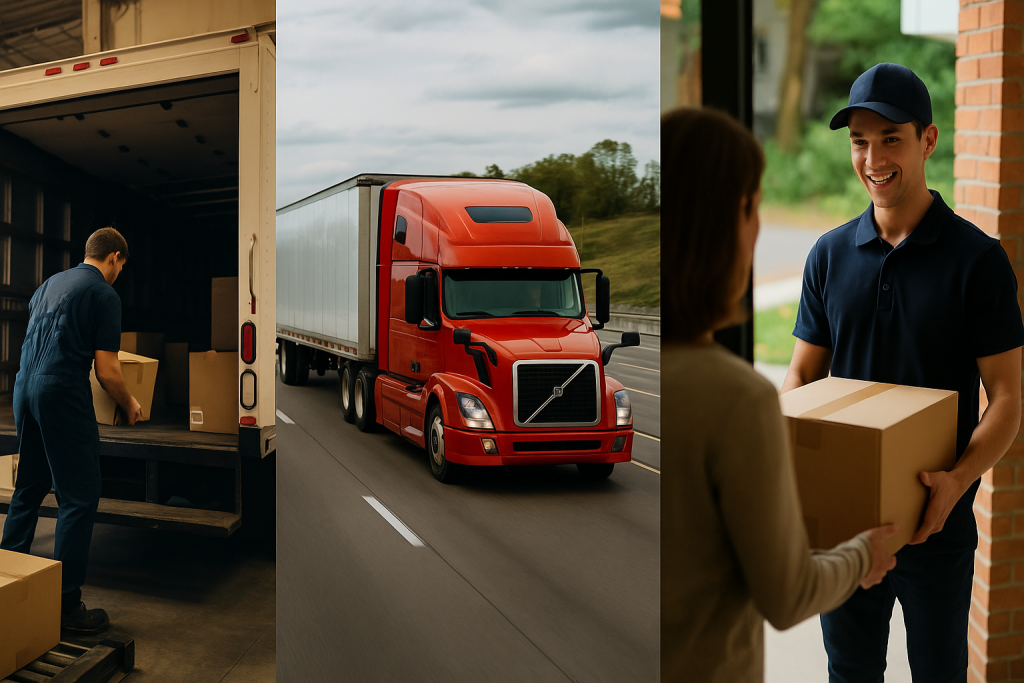By Martin Vassilev / 6 Oct, 2025
Understanding the difference between first-mile, middle-mile, and last-mile logistics is essential for any business involved in supply chain, fulfillment, or distribution. These three stages define how goods move from production facilities to consumers. Optimizing each stage can dramatically reduce shipping costs, enhance speed, and improve customer satisfaction. Below is a comprehensive breakdown of each stage, how they work together, and why modern logistics strategies depend on effectively managing all three.
The first mile refers to the initial movement of goods from their point of origin — such as factories, farms, or import docks — to the first major hub in the supply chain, typically a warehouse, fulfillment center, or distribution hub. This stage sets the tone for the entire delivery process. Delays or inefficiencies at this stage can create bottlenecks down the line.
Supplier Pickup: Collecting goods from the manufacturing site or supplier.
Initial Transport: Using trucking, rail, or maritime shipping to move goods to regional distribution centers.
Customs and Documentation: For international goods, this involves customs clearance, proper labeling, and regulatory compliance.
Early Tracking: Modern logistics companies leverage real-time tracking even at this stage to minimize uncertainty.
For example, companies moving products from overseas manufacturing facilities must ensure smooth customs clearance and regulatory compliance. Delays in paperwork can lead to cascading delays throughout the supply chain. According to the Government of Canada’s Import/Export Guide, proper documentation and classification of goods are mandatory for seamless first-mile operations.
Unpredictable manufacturing lead times
Port congestion and customs delays
Lack of visibility between manufacturers and carriers
Inefficient consolidation of shipments
Many logistics providers now integrate AI-driven forecasting tools to improve predictability at this stage. Data analytics allow businesses to anticipate port delays or factory slowdowns and reroute goods accordingly. Some firms use cross-docking solutions to bypass storage altogether and move shipments directly toward the next mile, improving overall efficiency (see how cross-docking works).
The middle mile represents the movement of goods between warehouses, fulfillment centers, regional hubs, and distribution networks. It connects the upstream supply from the first mile to the downstream customer delivery in the last mile. This stage often covers bulk transportation, and its efficiency can make or break operational margins.
Regional Distribution: Moving goods from main fulfillment hubs to regional or local distribution centers.
Inventory Balancing: Optimizing stock levels across multiple hubs to meet demand.
Freight Consolidation: Grouping shipments to reduce per-unit transportation costs.
Intermodal Transportation: Combining trucking, rail, and sometimes air for cost-effective and timely delivery.
In Canada and the U.S., middle-mile logistics often involves moving goods across provinces or states — for example, Calgary–Dallas corridors are increasingly strategic for cross-border logistics due to their growing warehousing capacity and trade volumes (Calgary–Dallas logistics hubs).
Capacity constraints in trucking and rail networks
Inefficient routing between hubs
Poor coordination between 3PL (Third-Party Logistics) partners
Seasonal fluctuations causing demand surges
Warehouse Automation – Automated picking, packing, and routing systems improve flow between hubs. Companies leveraging robotics and AI are dramatically reducing turnaround times in distribution (warehouse automation trends).
Smart Routing Software – Modern logistics platforms utilize machine learning to dynamically adjust routes based on traffic, weather, and capacity.
Intermodal Efficiency – Utilizing rail for long distances and trucks for shorter segments can cut costs while maintaining delivery speed.
Strategic Hub Placement – Selecting fulfillment hubs near major transportation arteries can improve delivery times and reduce costs. This is particularly vital for companies scaling operations across North America.
Middle-mile logistics is often overlooked because it’s less visible to end customers. However, its efficiency impacts both cost and last-mile performance.
Last-mile logistics refers to the final stage of the supply chain: moving goods from local distribution centers to the end customer’s doorstep. This stage is the most customer-facing and typically the most expensive per mile, accounting for more than 50% of total shipping costs for many eCommerce companies.
Local Sorting and Dispatching – Preparing orders for final delivery routes.
Real-Time Tracking – Offering customers accurate delivery windows and updates.
Fleet Management – Coordinating couriers, vans, or sometimes drones to execute delivery.
Customer Experience – Ensuring packages arrive on time, intact, and with options like same-day or next-day delivery.
High delivery costs for dispersed destinations
Traffic congestion in urban areas
Failed deliveries due to customer unavailability
Rising customer expectations for free and fast shipping
For businesses in metropolitan hubs like Ottawa, last-mile logistics is increasingly reliant on real-time tracking and local courier networks (Ottawa logistics overview) to meet consumer expectations for same-day service.
Route Optimization Software – Reduces mileage and increases the number of successful deliveries per route.
Urban Micro-Fulfillment Centers – Smaller, strategically placed warehouses bring inventory closer to customers, improving delivery speed.
Crowdsourced Delivery Models – Leveraging gig economy workers for flexible capacity during peak seasons.
Electric and Eco-Friendly Fleets – Companies are transitioning to sustainable delivery methods to align with environmental goals (U.S. Department of Transportation’s sustainability initiatives).
By leveraging technology, logistics providers can reduce last-mile costs and improve customer satisfaction, making it a key competitive differentiator.

The real power of logistics lies in seamless integration between first-mile, middle-mile, and last-mile stages. A delay in the first mile — for example, late factory pickups — affects middle-mile routing and last-mile availability. Similarly, bottlenecks in the middle mile can cause warehouse overflows and delivery delays downstream.
Visibility Across the Chain: Unified data platforms enable real-time visibility from supplier to customer.
Flexible Warehousing: Using dynamic warehousing models such as on-demand warehousing can improve both middle-mile and last-mile responsiveness (on-demand warehousing explained).
Analytics-Driven Decision Making: Advanced analytics allow businesses to pinpoint inefficiencies at any stage and optimize accordingly.
Strategic Partnerships with 3PLs: Partnering with experienced logistics providers ensures smooth coordination between miles, especially for cross-border and high-volume operations.
Logistics in 2025 and beyond is being reshaped by AI, robotics, green logistics, and data-driven optimization. Companies are no longer treating these stages in isolation but as an integrated end-to-end logistics ecosystem.
AI in Logistics: Predictive analytics and automation are enhancing forecasting, routing, and fulfillment (AI in logistics).
Green Logistics: Sustainable practices are becoming a regulatory and consumer expectation.
Real-Time Data: Transparency at all stages builds trust and resilience.
Distributed Warehousing: Companies are moving inventory closer to major markets to improve last-mile responsiveness while optimizing middle-mile cost structures.
Understanding the difference between first-mile, middle-mile, and last-mile logistics allows businesses to design efficient, cost-effective, and customer-centric supply chains. Companies that invest in visibility, automation, and strategic hub placement can minimize disruptions, reduce shipping costs, and increase customer satisfaction.
Whether shipping bulk freight across borders or delivering a same-day parcel downtown, each mile plays a critical role in the overall logistics puzzle. Businesses that integrate and optimize all three will dominate in speed, reliability, and profitability.
For customized logistics solutions tailored to your business needs, contact ByExpress — a trusted partner in warehousing, distribution, and delivery across Canada and the U.S.

“Thanks to Byexpress all my shipping and fulfillment costs are in line now”

“All my issues were solved by Byexpress team that I had with pervious 3pl provider.”

“Thank you Byexpress team could not done it without you guys.”

“Their integration and customer service were the key for me”

“Outstanding delivery service! The package was well-packaged, and
the delivery team was professional and courteous”

“Great and knowledgeable team to work with.”

Thanks, guys, for reducing my shipping rates
Ottawa Office
2411 Holly Lane
Ottawa, ON, K1V 7P2
Toronto Office
13-280 West Beaver Creek Road Unit #136
Richmond Hill, ON, L4B 3Z1
Alexandria Office
173 Kenyon Street West
Alexandria, ON, K0C 1A0
Montreal Office
4388 Saint-Denis Street Unit #200
Montreal, QC, H2J 2L1
California Office
155 North Riverview Drive
Anaheim Hills, CA, 92808
Call Us
Toll-Free: 1-866-744-7122
Local : 613-739-3000
Email Us
Multilingual Services










